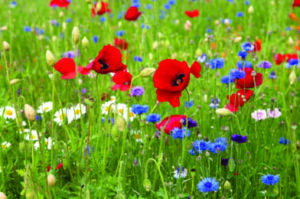By Jessie Clark
Master Gardener
Cool season crops are trending again in the world of gardening! As commercial flower grower and podcaster Lisa Mason Ziegler shares, cool season crops are not a new concept. It’s how our grandparents gardened decades ago. The idea behind planting cool season crops is that there are plants that not only tolerate cooler weather – they actually thrive in it. Most of the growth in cool season flowers will take place beneath the surface during the winter, establishing roots. Watering is lighter during this season than it is in the hotter months, as water evaporates less quickly. Some regions can get away without watering cool season crops, however I find that in our area some irrigated watering helps the plants establish. By early Spring, cool season flower crops are ready for harvest.

Flowering varieties include carnations, lambada, corn cockle, statice, atriplex, stock, strawflower, bells of Ireland, golden drumstick, giant poppy pods and champagne bubbles poppies, snapdragons, pincushion, godetia, soapwort, baby’s breath, bachelor button, sweet William, Larkspur, sweet pea vines, love-in-a-mist, white lace flower, black-eyed susan, Chinese forget-me-nots, pot marigold, bupleurum, false queen anne’s lace, ammi and ammi majus, dill, feverfew and yarrow. Pay close attention to seed germination instructions for a successful crop. For gardeners who tend towards vegetables, consider adding flowers to your garden to help attract beneficial pollinators. These insects will help you fend off insects that can be pests in your garden, making gardening more enjoyable and also more beautiful. Some people create adjacent beds for flowers, some people sprinkle flower seeds in the same beds as their vegetables.
Vegetables that thrive in cooler conditions include asparagus, beets, broccoli, brussels sprouts, chives, cabbage, carrots, cauliflower, swiss chard, kale, leek, lettuce, onion, parsnips, peas, radishes, spinach and turnips. This year we planted butter crunch lettuce, red lettuce, brussels sprouts, broccoli, cauliflower, and multiple varieties of kale. We’ve enjoyed delicious, fresh salads for dinner this month.
A common question is timing for planting cool season flowers. Just as we count down to the last frost date in April for warm season annuals, keep an eye on the first frost date for cool season annuals. Ideally, any seeds that need to be started indoors will already have been started before the first frost date and will be in the ground shortly after. With our mild winters and late frost date this year, I believe you can still get away with planting some of your favorite cool season flowers and vegetables this winter – especially if you’re planting seedlings purchased from a store that have already been started for you.




